Jiahao Liu
World In Your Hands: A Large-Scale and Open-source Ecosystem for Learning Human-centric Manipulation in the Wild
Dec 30, 2025Abstract:Large-scale pre-training is fundamental for generalization in language and vision models, but data for dexterous hand manipulation remains limited in scale and diversity, hindering policy generalization. Limited scenario diversity, misaligned modalities, and insufficient benchmarking constrain current human manipulation datasets. To address these gaps, we introduce World In Your Hands (WiYH), a large-scale open-source ecosystem for human-centric manipulation learning. WiYH includes (1) the Oracle Suite, a wearable data collection kit with an auto-labeling pipeline for accurate motion capture; (2) the WiYH Dataset, featuring over 1,000 hours of multi-modal manipulation data across hundreds of skills in diverse real-world scenarios; and (3) extensive annotations and benchmarks supporting tasks from perception to action. Furthermore, experiments based on the WiYH ecosystem show that integrating WiYH's human-centric data significantly enhances the generalization and robustness of dexterous hand policies in tabletop manipulation tasks. We believe that World In Your Hands will bring new insights into human-centric data collection and policy learning to the community.
Independent Density Estimation
Dec 21, 2025Abstract:Large-scale Vision-Language models have achieved remarkable results in various domains, such as image captioning and conditioned image generation. Nevertheless, these models still encounter difficulties in achieving human-like compositional generalization. In this study, we propose a new method called Independent Density Estimation (IDE) to tackle this challenge. IDE aims to learn the connection between individual words in a sentence and the corresponding features in an image, enabling compositional generalization. We build two models based on the philosophy of IDE. The first one utilizes fully disentangled visual representations as input, and the second leverages a Variational Auto-Encoder to obtain partially disentangled features from raw images. Additionally, we propose an entropy-based compositional inference method to combine predictions of each word in the sentence. Our models exhibit superior generalization to unseen compositions compared to current models when evaluated on various datasets.
MonkeyOCR v1.5 Technical Report: Unlocking Robust Document Parsing for Complex Patterns
Nov 16, 2025Abstract:Document parsing is a core task in document intelligence, supporting applications such as information extraction, retrieval-augmented generation, and automated document analysis. However, real-world documents often feature complex layouts with multi-level tables, embedded images or formulas, and cross-page structures, which remain challenging for existing OCR systems. We introduce MonkeyOCR v1.5, a unified vision-language framework that enhances both layout understanding and content recognition through a two-stage pipeline. The first stage employs a large multimodal model to jointly predict layout and reading order, leveraging visual information to ensure sequential consistency. The second stage performs localized recognition of text, formulas, and tables within detected regions, maintaining high visual fidelity while reducing error propagation. To address complex table structures, we propose a visual consistency-based reinforcement learning scheme that evaluates recognition quality via render-and-compare alignment, improving structural accuracy without manual annotations. Additionally, two specialized modules, Image-Decoupled Table Parsing and Type-Guided Table Merging, are introduced to enable reliable parsing of tables containing embedded images and reconstruction of tables crossing pages or columns. Comprehensive experiments on OmniDocBench v1.5 demonstrate that MonkeyOCR v1.5 achieves state-of-the-art performance, outperforming PPOCR-VL and MinerU 2.5 while showing exceptional robustness in visually complex document scenarios. A trial link can be found at https://github.com/Yuliang-Liu/MonkeyOCR .
Balancing Knowledge Updates: Toward Unified Modular Editing in LLMs
Oct 31, 2025
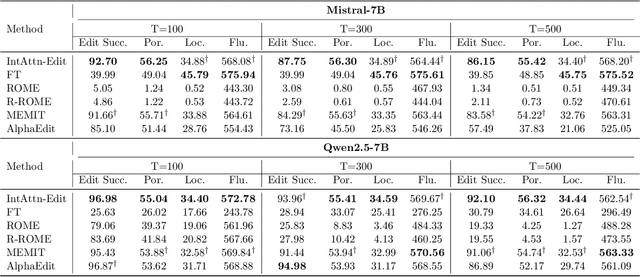
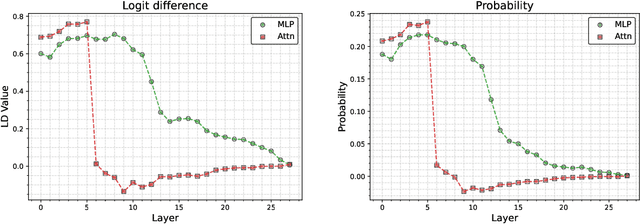
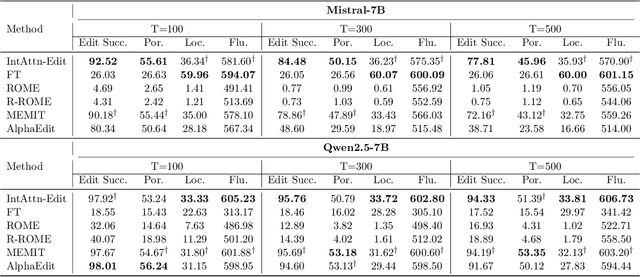
Abstract:Knowledge editing has emerged as an efficient approach for updating factual knowledge in large language models (LLMs). It typically locates knowledge storage modules and then modifies their parameters. However, most existing methods focus on the weights of multilayer perceptron (MLP) modules, which are often identified as the main repositories of factual information. Other components, such as attention (Attn) modules, are often ignored during editing. This imbalance can leave residual outdated knowledge and limit editing effectiveness. We perform comprehensive knowledge localization experiments on advanced LLMs and find that Attn modules play a substantial role in factual knowledge storage and retrieval, especially in earlier layers. Based on these insights, we propose IntAttn-Edit, a method that extends the associative memory paradigm to jointly update both MLP and Attn modules. Our approach uses a knowledge balancing strategy that allocates update magnitudes in proportion to each module's measured contribution to knowledge storage. Experiments on standard benchmarks show that IntAttn-Edit achieves higher edit success, better generalization, and stronger knowledge preservation than prior methods. Further analysis shows that the balancing strategy keeps editing performance within an optimal range across diverse settings.
IIET: Efficient Numerical Transformer via Implicit Iterative Euler Method
Sep 26, 2025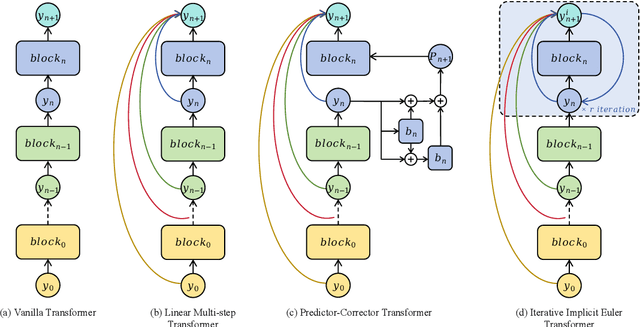
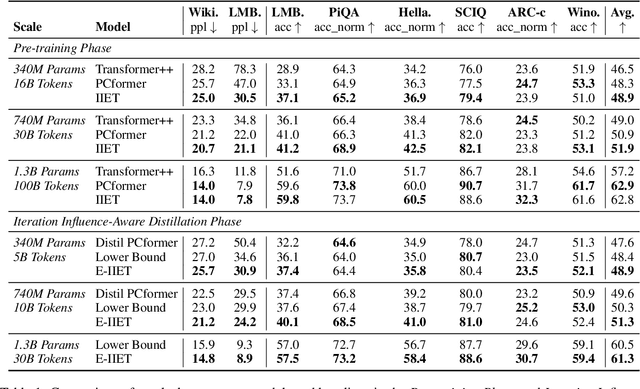
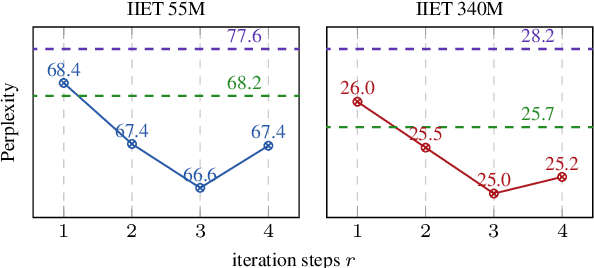

Abstract:High-order numerical methods enhance Transformer performance in tasks like NLP and CV, but introduce a performance-efficiency trade-off due to increased computational overhead. Our analysis reveals that conventional efficiency techniques, such as distillation, can be detrimental to the performance of these models, exemplified by PCformer. To explore more optimizable ODE-based Transformer architectures, we propose the \textbf{I}terative \textbf{I}mplicit \textbf{E}uler \textbf{T}ransformer \textbf{(IIET)}, which simplifies high-order methods using an iterative implicit Euler approach. This simplification not only leads to superior performance but also facilitates model compression compared to PCformer. To enhance inference efficiency, we introduce \textbf{I}teration \textbf{I}nfluence-\textbf{A}ware \textbf{D}istillation \textbf{(IIAD)}. Through a flexible threshold, IIAD allows users to effectively balance the performance-efficiency trade-off. On lm-evaluation-harness, IIET boosts average accuracy by 2.65\% over vanilla Transformers and 0.8\% over PCformer. Its efficient variant, E-IIET, significantly cuts inference overhead by 55\% while retaining 99.4\% of the original task accuracy. Moreover, the most efficient IIET variant achieves an average performance gain exceeding 1.6\% over vanilla Transformer with comparable speed.
TCPO: Thought-Centric Preference Optimization for Effective Embodied Decision-making
Sep 10, 2025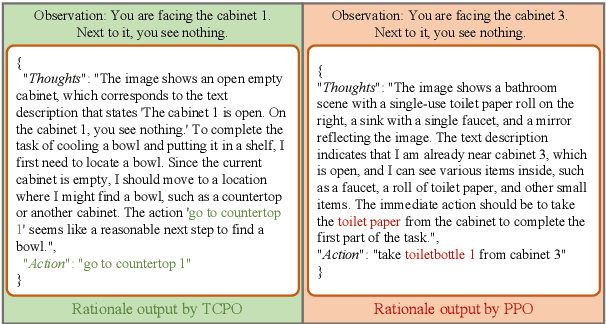

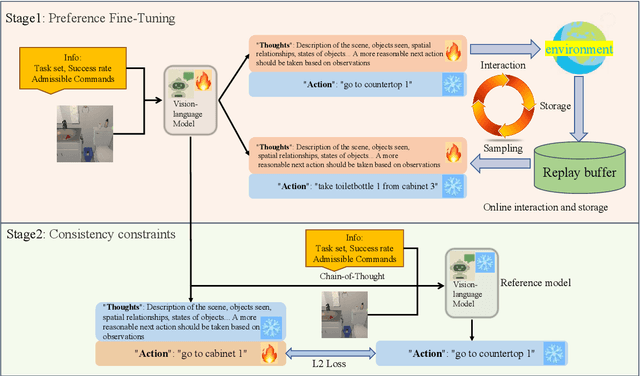

Abstract:Using effective generalization capabilities of vision language models (VLMs) in context-specific dynamic tasks for embodied artificial intelligence remains a significant challenge. Although supervised fine-tuned models can better align with the real physical world, they still exhibit sluggish responses and hallucination issues in dynamically changing environments, necessitating further alignment. Existing post-SFT methods, reliant on reinforcement learning and chain-of-thought (CoT) approaches, are constrained by sparse rewards and action-only optimization, resulting in low sample efficiency, poor consistency, and model degradation. To address these issues, this paper proposes Thought-Centric Preference Optimization (TCPO) for effective embodied decision-making. Specifically, TCPO introduces a stepwise preference-based optimization approach, transforming sparse reward signals into richer step sample pairs. It emphasizes the alignment of the model's intermediate reasoning process, mitigating the problem of model degradation. Moreover, by incorporating Action Policy Consistency Constraint (APC), it further imposes consistency constraints on the model output. Experiments in the ALFWorld environment demonstrate an average success rate of 26.67%, achieving a 6% improvement over RL4VLM and validating the effectiveness of our approach in mitigating model degradation after fine-tuning. These results highlight the potential of integrating preference-based learning techniques with CoT processes to enhance the decision-making capabilities of vision-language models in embodied agents.
Stop Spinning Wheels: Mitigating LLM Overthinking via Mining Patterns for Early Reasoning Exit
Aug 25, 2025



Abstract:Large language models (LLMs) enhance complex reasoning tasks by scaling the individual thinking process. However, prior work shows that overthinking can degrade overall performance. Motivated by observed patterns in thinking length and content length, we categorize reasoning into three stages: insufficient exploration stage, compensatory reasoning stage, and reasoning convergence stage. Typically, LLMs produce correct answers in the compensatory reasoning stage, whereas reasoning convergence often triggers overthinking, causing increased resource usage or even infinite loops. Therefore, mitigating overthinking hinges on detecting the end of the compensatory reasoning stage, defined as the Reasoning Completion Point (RCP). RCP typically appears at the end of the first complete reasoning cycle and can be identified by querying the LLM sentence by sentence or monitoring the probability of an end-of-thinking token (e.g., \texttt{</think>}), though these methods lack an efficient and precise balance. To improve this, we mine more sensitive and consistent RCP patterns and develop a lightweight thresholding strategy based on heuristic rules. Experimental evaluations on benchmarks (AIME24, AIME25, GPQA-D) demonstrate that the proposed method reduces token consumption while preserving or enhancing reasoning accuracy.
Bidirectional Knowledge Distillation for Enhancing Sequential Recommendation with Large Language Models
May 23, 2025Abstract:Large language models (LLMs) have demonstrated exceptional performance in understanding and generating semantic patterns, making them promising candidates for sequential recommendation tasks. However, when combined with conventional recommendation models (CRMs), LLMs often face challenges related to high inference costs and static knowledge transfer methods. In this paper, we propose a novel mutual distillation framework, LLMD4Rec, that fosters dynamic and bidirectional knowledge exchange between LLM-centric and CRM-based recommendation systems. Unlike traditional unidirectional distillation methods, LLMD4Rec enables iterative optimization by alternately refining both models, enhancing the semantic understanding of CRMs and enriching LLMs with collaborative signals from user-item interactions. By leveraging sample-wise adaptive weighting and aligning output distributions, our approach eliminates the need for additional parameters while ensuring effective knowledge transfer. Extensive experiments on real-world datasets demonstrate that LLMD4Rec significantly improves recommendation accuracy across multiple benchmarks without increasing inference costs. This method provides a scalable and efficient solution for combining the strengths of both LLMs and CRMs in sequential recommendation systems.
UAV-Enabled Joint Sensing, Communication, Powering and Backhaul Transmission in Maritime Monitoring Networks
May 18, 2025Abstract:This paper addresses the challenge of energy-constrained maritime monitoring networks by proposing an unmanned aerial vehicle (UAV)-enabled integrated sensing, communication, powering and backhaul transmission scheme with a tailored time-division duplex frame structure. Within each time slot, the UAV sequentially implements sensing, wireless charging and uplink receiving with buoys, and lastly forwards part of collected data to the central ship via backhaul links. Considering the tight coupling among these functions, we jointly optimize time allocation, UAV trajectory, UAV-buoy association, and power scheduling to maximize the performance of data collection, with the practical consideration of sea clutter effects during UAV sensing. A novel optimization framework combining alternating optimization, quadratic transform and augmented first-order Taylor approximation is developed, which demonstrates good convergence behavior and robustness. Simulation results show that under sensing quality-of-service constraint, buoys are able to achieve an average data rate over 22bps/Hz using around 2mW harvested power per active time slot, validating the scheme's effectiveness for open-sea monitoring. Additionally, it is found that under the influence of sea clutters, the optimal UAV trajectory always keeps a certain distance with buoys to strike a balance between sensing and other multi-functional transmissions.
Dynamic Fisher-weighted Model Merging via Bayesian Optimization
Apr 26, 2025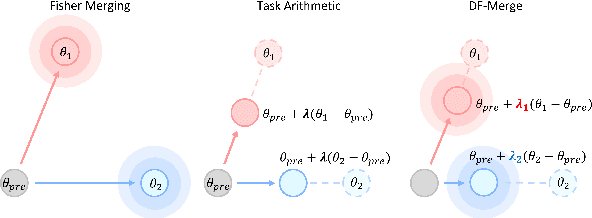



Abstract:The fine-tuning of pre-trained language models has resulted in the widespread availability of task-specific models. Model merging offers an efficient way to create multi-task models by combining these fine-tuned models at the parameter level, without the need for training data or joint training on multiple datasets. Existing merging approaches typically involve scaling the parameters model-wise or integrating parameter importance parameter-wise. Both approaches exhibit their own weaknesses, leading to a notable performance gap compared to multi-task fine-tuning. In this paper, we unify these seemingly distinct strategies into a more general merging framework, and introduce Dynamic Fisher-weighted Merging (DF-Merge). Specifically, candidate models are associated with a set of coefficients that linearly scale their fine-tuned parameters. Bayesian optimization is applied to dynamically adjust these coefficients, aiming to maximize overall performance on validation sets. Each iteration of this process integrates parameter importance based on the Fisher information conditioned by the coefficients. Experimental results show that DF-Merge outperforms strong baselines across models of different sizes and a variety of tasks. Our analysis shows that the effectiveness of DF-Merge arises from the unified view of merging and that near-optimal performance is achievable in a few iterations, even with minimal validation data.
 Add to Chrome
Add to Chrome Add to Firefox
Add to Firefox Add to Edge
Add to Edge